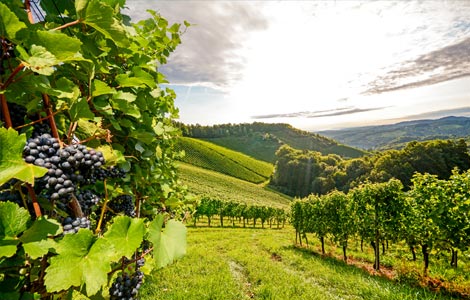
- Boron is essential for all plant growth. It is import for cell wall structure, root growth, and pollination.
- Grapes require an adequate supply of available boron, especially during flowering and fruit set.
- Multiple foliar sprays of Solubor® applied alone or with insecticides will ensure an adequate supply of boron during the critical stages of flowering and berry development.
- Preplant soil application of Granubor® plus foliar sprays of Solubor during the season are recommended for soils testing low in available boron.
Grapes grow best in sandy soils, but these soils also tend to be low in available boron, which is a key nutrient for vine growth, and fruit set and quality. While boron is essential for all stages of plant growth, an available supply is most important during flowering and fruit development.
Boron is phloem immobile in grapes making it difficult to retranslocate boron to new flower buds, so spray applications of Solubor at flowering will ensure an adequate supply during this critical reproductive stage. Cell wall strength, cell division, fruit and seed development are some of the plant functions related to boron.
Available boron in the soil is mainly associated with organic matter content, which must be mineralized to release boron for plant uptake. While boron requirements for optimum plant nutrition are low compared with those of the primary nutrients, the need for boron is especially significant in fruit development.
Deficiency symptoms
Because boron is vital to flower formation, fruit set and development, a decrease in boron supply during these critical stages can result in decreased yields. The first boron deficiency symptoms appear before bloom on the shoot tips and on stalks of inflorescence, with dark, knotty bulges forming and becoming necrotic, as well as shortened internodes. Flower clusters may die.
Younger internodes may swell and darken during rapid shoot growth. Older internodes develop swellings with deep folds and pits, which are the most characteristic boron deficiency symptoms. Leaves may have short, thick petioles with necrotic spots.
Leaves may have a light mosaic pattern of chlorosis in interveinal areas and red-brown spots interveinally and on the margins. Roots may remain short, thicken, swell into knots and break open longitudinally.
Soil tests and plant analyses
Soil testing and plant analyses are both helpful in assessing the potential boron-supplying capacity of the soil and the current boron status of the growing plant.
The critical level of hot-water-soluble boron for grapes in most soils is less than 0.5 ppm, depending on the soil pH, organic matter content and texture. The availability of boron in acid soils generally decreases when these soils are limed.
Results have shown that boron applications may improve grape yield and quality when boron soil test levels are less than 0.4 ppm in sandy soils which have been limed to pH 6.2 or higher, and less than 0.5 ppm in fine-textured soils which have been limed to pH 6.0 or higher.
The critical level of boron in the top mature grape leaves is about 20 ppm, but the ideal range is from 25-50 ppm. Trees with leaf boron contents below the critical level should be sprayed one or more times with Solubor after flower initiation and during fruit set and development. Leaf concentrations over 80 ppm of boron may indicate possible boron toxicity.
DOWNLOAD PDF FOR CHARTS
Recommendations for grapes
Yield responses to applied boron may be inconsistent and seasonal, probably due to environmental effects on flowering and berry development. However, both yield and quality of grapes may be improved with boron applications because available boron levels are low in some soils.
Boron should be applied for grapes, especially on sandy soils in high rainfall regions or with over-irrigation because soluble boron can be easily leached from the root zone. Response to applied boron generally is greatest when there are adequate supplies of other nutrients.
Data below show increased boron uptake with broadcast and berm spray applications of Solubor to soil. Berm spray applications (providing 1.5 lbs of B/acre annually or biannually) resulted in greater boron uptake than broadcasting boron over the entire soil area at higher boron rates, possibly because most of the roots are located in the berm region of soil.
DOWNLOAD PDF FOR CHARTS
Download Agronomy Notes